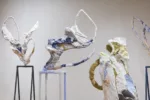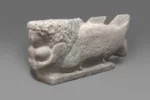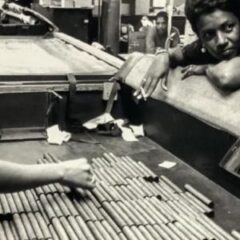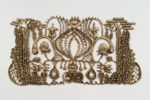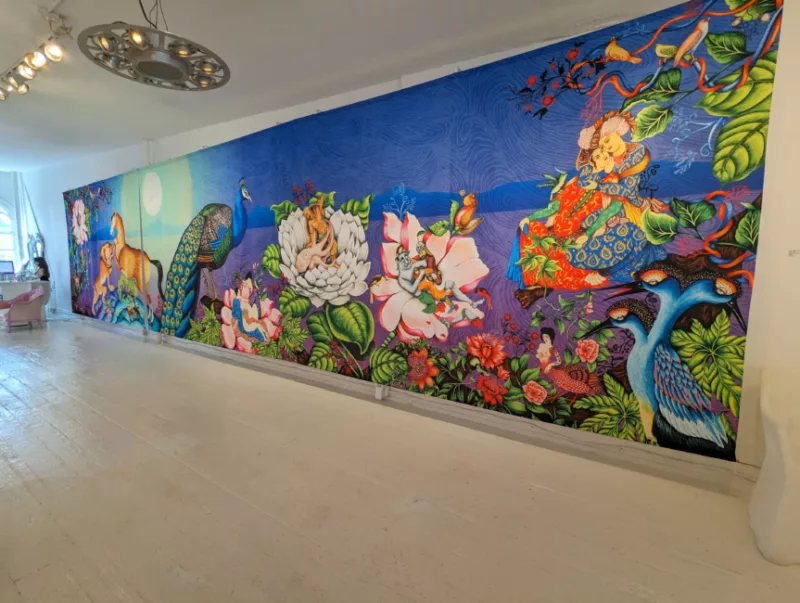
Heather Ujiie’s exhibition, Lost in Paradise (June 17th- August 12th) is a journey.
The viewer must first endure the stairway that surely leads to heaven, but also to the 4th floor and James Oliver Gallery. At the top of the stairs, huffing and puffing, you enter Heather Ujiie’s strange and beautiful world. It is a wild mix of the refined and the childlike. We have both gilded peacocks and imagined birds with running shoes. This is what you are in for.
Ujiie’s monumental textile piece, “War and Peace in the Time of Covid” stretches an ambitious 36 feet across the gallery. This sexy and violent narrative scene alludes to an operatic affair between star-crossed lovers. The imagery is composed of hand-painted pictures of Ujiie’s own hybrid creatures and characters, inspired by her study of Persian miniature paintings, Chinese erotic paintings of the Qing Dynastic era, and Japanese Shunga. Some of these original paintings are on view in the gallery.
Ujiie comes from a textile print design background in New York City, where she grew up with a family of artist educators. She spent 15 years designing for fashion and home furnishings, and also spent time designing costumes for avant-garde theater productions. After moving to Philadelphia more than 20 years ago, she continued to explore art & design, and eventually began teaching full-time at Moore College of Art & Design. Her past professional work is evident in her new pieces, but her personal journey as a multidisciplinary artist has sent her on a foray into sculpture construction using diverse and unexpected materials.
Press deeper into the gallery as if on a jungle expedition; there, we are confronted by a great horned goddess and its whimsical 3 legged counterpart. The two figures make an excellent team; a sorceress and its familiar casting the magic that activates Ujiie’s work. Most recently, Ujiie has expanded her practice to include fiber art based figurative works. These creatures have become her friends and confidants.
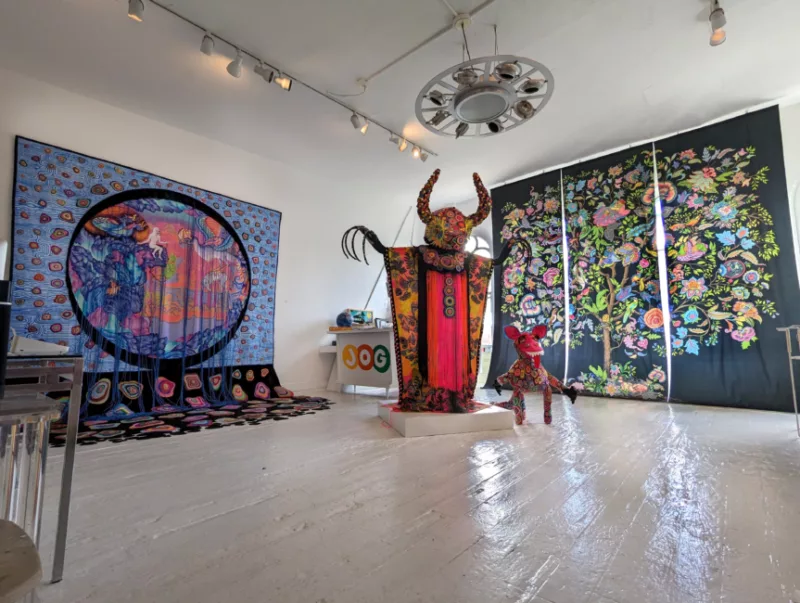
Just behind this duo of characters is a textile installation entitled “Zual & The Simborgh.” This new work is inspired by one of the many tales in the Persian 10th-century epic poem of the story of Shahnameh, The Book of Kings. This dynamic piece marries two and three dimensions, and might include the 4th dimension. “Zual and the Simborgh” is a hand-quilted wall hanging with an ocular window into Ujiie’s paradisiacal world. The scene is obscured by a waterfall of blue paracord, which spills into a black pool of floating islands that seem to be flowing out of the scene into a body of silent water. If only we could wade into the pool, and step through the opening in the waterfall into the scene and join Ujiie’s paradise.
The work Ujiie is most excited about is her piece “Tree of Life,” a triptych textile digitally printed on poly velvet. This work had to be printed several times to correctly capture the complexity and luminosity of her hand-painted motifs against a black background. Let’s all take a moment to appreciate the difficulty of printing on velvet.
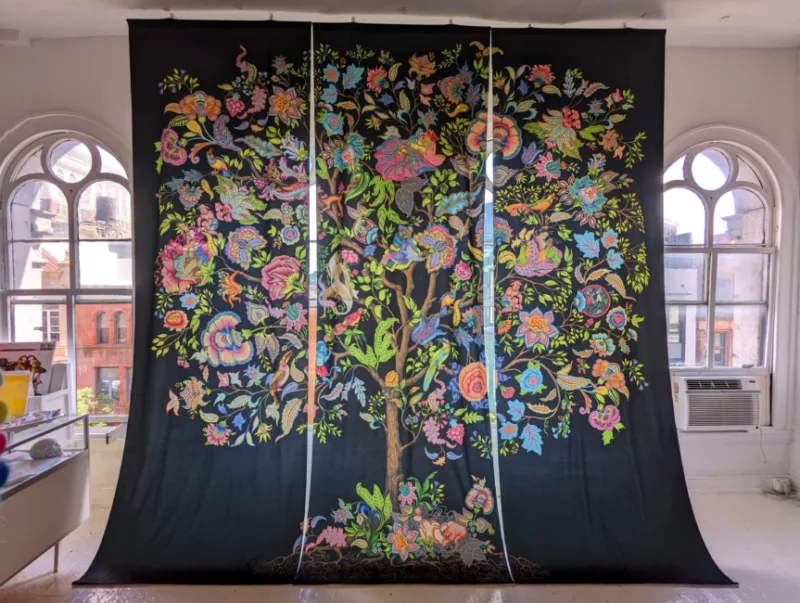
If this is your first experience with Ujiie’s work, you may be standing with a finger on your chin in the gallery, eyes narrowed, questioning just how her textile works are made. It is a complex process; She begins by painting the details of her work with gouache. Her paintings are so tightly rendered that they can easily be mistaken for prints. These hand-painted images are scanned at a high resolution, and integrated digitally into panoramic landscapes. The printed textiles may look to viewers like a purely digital fabrication, but the works are actually a combination of hand and digital techniques and are quite unique in that way. Influenced by the digital surface imaging expertise of her husband, Hitoshi Ujiie, she has gone on to expand her practice to push the boundaries of surface design and artmaking.
Ujiie’s work deserves to be viewed in a cavernous white painted space, devoid of distractions. The James Oliver Gallery is no such space. But, let’s also take a moment to appreciate James Oliver Gallery for what it is. It must surely be a Philadelphia art institution by now. Oliver, an artist himself, has amassed a serious collection of royal looking chairs, figurines, and small pieces of art and ephemera that decorate the kitchen and lounge area. There’s a small piece by John Wind, a reproduction of Michelangelo’s David atop a bright orange shelf full of sales items which is clad in a collection of watches and rings and fake pearl necklaces- one of which has a large charm that says “Elvis”. The gallery is art, itself.
Heather Ujiie is an ambitious artist and designer who is mindful of craftsmanship but not tied to it in any way. She allows herself to play and experiment, and over the last 2 or 3 years has produced a significant body of new work. Catch Lost in Paradise, at the James Oliver Gallery in Philadelphia until August 12th. Ujiie’s will be giving an artist talk in the gallery on July 21st, 6-8:30 pm. I’ve been privileged to install Ujiie’s work on two occasions, and am rather smitten with it. I wanted to write this review because I believe Heather Ujiie’s journey is one to watch.


